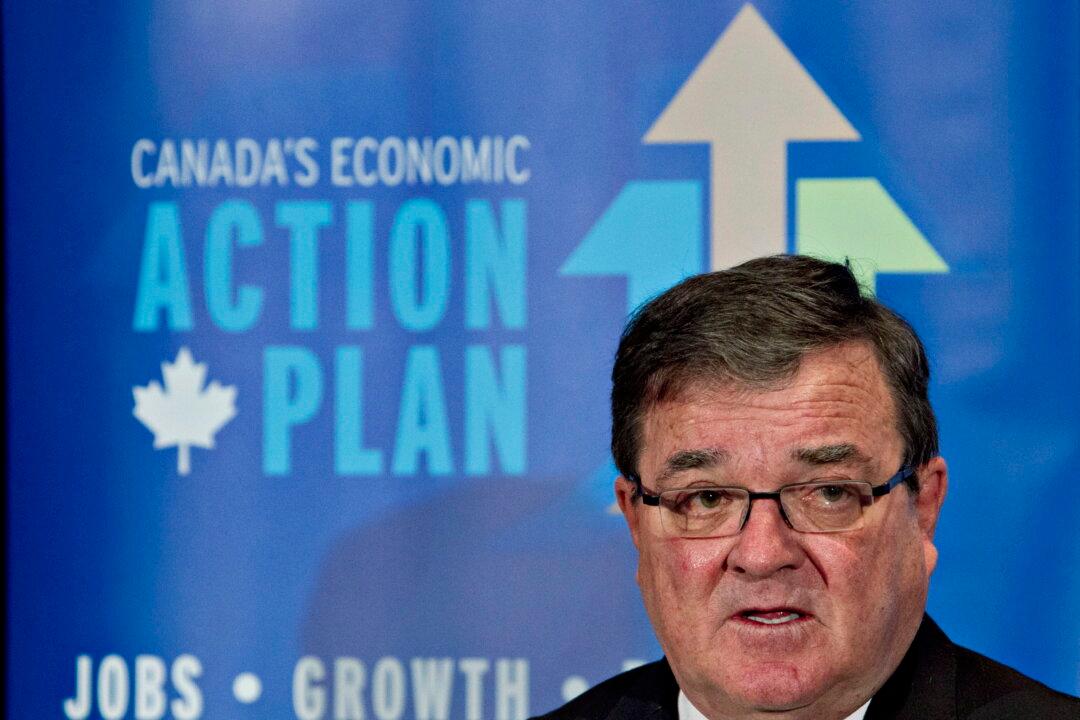OTTAWA—The Harper government will end seven years of deficits in 2015 with a $3.7 billion surplus, said Finance Minister Jim Flaherty.
The new projection, nearly $3 billion better than the March budget forecast, was part of Tuesday’s fall economic update. A day later, more good news came when Standard & Poor’s reaffirmed Canada’s AAA credit rating.
Besides new estimates of the government’s fiscal position, Flaherty’s mid-year update, contained a few surprises, including plans for future asset sales and a costing of savings tied to the recently announced departmental spending freeze.
“We’re on track to get back to balance in 2015, without raising taxes or cutting investments in health care and social service transfers, as promised,” Flaherty declared in a news release Tuesday.
In a news release Wednesday, Flaherty noted that the Standard & Poor’s report highlighted Canada’s stable and credible policymaking and a highly resilient economy, even amid a fragile global economy.
“The report also touts high investor confidence, and in particular our continued openness to trade, as reliable indicators of Canada’s future economic success,” Flaherty stated, referring to the recently announced agreement in principle on a comprehensive trade agreement with the European Union.
$3 Billion Risk Buffer
For its part, the economic update takes a cautious approach to the economic reality facing Canada and how it will affect the government’s books.
Flaherty has included a $3 billion risk buffer in his baseline calculations, meaning unless the global or Canadian economies perform much worse going forward, the government could find itself sitting on a $6.7 billion surplus in an election year.
In the 2011 campaign, Prime Minister Stephen Harper said a Conservative government would offer Canadian couples with children under 18 the option of splitting their income to reduce taxes—once the budget was balanced.
By some calculations, that would deprive Ottawa of about $2.7 billion in revenues.
Harper also promised several other boutique tax cuts, as well as a doubling of the $5,000 annual limit on contributions to tax-free savings accounts, all contingent on balanced books—pledges that would shave about $600 million more from tax revenues.
Opposition critics suggested the government numbers cannot be trusted. The Liberals said much of the improved fiscal picture comes from employment insurance savings, and that the government should have cut premiums sooner. By 2015–16, the fund is projected to have a $5.6 billion surplus, accounting for more than the total surplus on the government books.
Better-than-expected Savings
In the current fiscal year, Flaherty said he expects a $17.9 billion deficit—$1 billion below the previous year’s shortfall—as a result of better-than-expected savings from cost-cutting and lower interest charges that more than make up for lower revenues from slow economic growth.
Last month, Ottawa announced it was $7 billion ahead of pace in its deficit elimination track. In this year’s budget, Flaherty said, the government will need to pony up about $2.8 billion for disaster relief related to the Alberta floods, and another $60 million already committed for the Lac-Megantic train derailment in Quebec.
The deficit will fall to $5.5 billion in 2014–15 as a revived economy starts producing more tax revenues, he predicted.
Flaherty said the government also expects to realize about $1.65 billion in savings from the throne speech pledge to freeze internal departmental budgets, which will occur in the 2014–15 and 2015–16 fiscal years.
Another $2 billion in revenues will come over the next two years from selling the government’s remaining stake in General Motors, as well as the Ridley coal terminal in British Columbia and the Dominion Coal Blocks, two Crown lands also in B.C.
Also conservative is the projected savings from departmental spending restraints. In last year’s final tally, Ottawa admitted departments had underspent their limits by $5.2 billion, and “lapses” in spending may carry forward to future years.
The major new restraint is from the two-year departmental spending freeze, which builds on a previous standstill measure and the chopping of about 20,000 jobs. Most analysts believe department heads will need to cut more salaries in order to meet the target.
Moderate Growth Estimates
On economic prospects, Flaherty was given new growth estimates by private sector economists two weeks ago and they show the economy advancing by 1.7 percent this year, 2.4 percent next year, and 2.6 percent in 2015.
Those represent moderate growth rates, but from Ottawa’s point of view the more important numbers are those for nominal GDP, which is directly tied to tax revenues.
Those numbers have taken a hit because of lower-than-expected inflation. Next year’s nominal growth is now projected at 4.2 percent, down half a point from March’s estimate, which Ottawa says will slow revenues.
Also impacting the government’s bottom line is the continued discount markets put on western crude, which Flaherty attributes to lack of pipeline capacity. Ottawa estimates the lower price for Canadian oil has cost exporters about $7.6 billion on average since 2010.
Still, the government says its books are overall in better shape than it thought in March.
“Total economic and fiscal developments since budget 2013 have largely resulted in an improvement to the fiscal outlook, as weaker projected revenues are generally more than offset by lower projected expenses and public debt charges,” the update concludes.
With files from The Canadian Press




